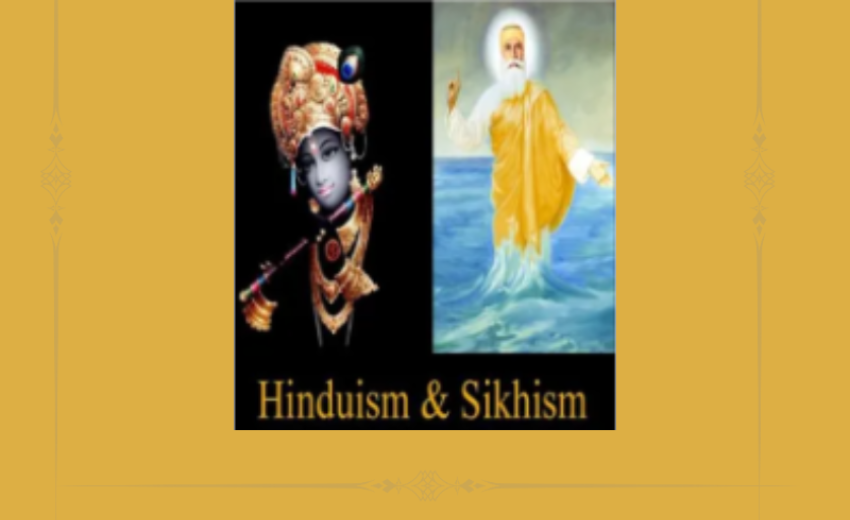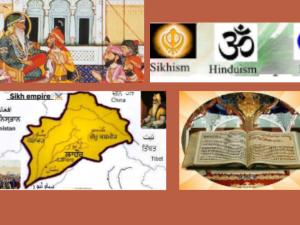Sikhism and Hinduism are two major religions that have originated in South Asia. While they share certain cultural and philosophical parallels due to their historical and geographical proximity, they also exhibit significant differences that reveal fascinating paradoxes between them. Understanding these parallels and paradoxes provides insight into the rich tapestry of South Asian spirituality and the diverse ways in which humans seek meaning and transcendence.
Historical Context and Development
Hinduism is one of the world's oldest religions, with roots extending back over 3,000 years. It is a rich and complex tapestry of beliefs, practices, and rituals, encompassing a wide range of diversity. Its sacred texts include the Vedas, Upanishads, Puranas, Mahabharata, Ramayana, and various regional texts. Hinduism is characterized by its diversity, incorporating various deities, philosophies, and ritual practices [1-2].
Sikhism, a religion that emerged in the 15th century in the Punjab region of South Asia, was born from a specific historical context. This context, where both Hinduism and Islam were prevalent, not only shaped the unique socio-religious perspective of Sikhism but also underlines its relevance in the contemporary world. The religion is centred around the teachings of Guru Nanak and the nine subsequent Gurus, culminating in the Guru Granth Sahib, the central religious scripture of Sikhism [3-4]. Understanding this historical context is crucial to appreciating the relevance and timeliness of Sikhism.
Theological Parallels Both Sikhism and Hinduism emphasize the concept of a divine, omnipresent reality. In Hinduism, this reality is often conceptualized through Brahman. This all-encompassing, transcendent force manifests in various forms, including the trinity of Brahma (the creator), Vishnu (the preserver), and Shiva (the destroyer). Sikhism, with a distinct theological perspective, rejects the polytheistic elements of Hinduism. It firmly believes in one formless God (Ik Oankar), who is beyond human comprehension and transcends all forms and attributes. This rejection of polytheism in Sikhism is not a rejection of Hinduism as a whole but a unique theological stance that adds to the diversity of spiritual thought.
Both religions also share a profound belief in the cyclical nature of existence, a concept that is deeply ingrained in the fabric of their spiritual philosophies. In Hinduism, this is articulated through the concepts of samsara (the cycle of birth, death, and rebirth) and karma (the law of moral causation). Sikhism, on the other hand, acknowledges the cycle of rebirth but emphasizes the ultimate goal of escaping this cycle through devotion to God and leading a righteous life.
Ritual Practices and Worship Hindu ritual practices are diverse, ranging from elaborate temple rituals and festivals to personal devotional practices. Hindu worship often involves offerings to deities, chanting of mantras, and participation in pujas (rituals). Sikhism, in contrast, simplifies and refines ritual practices. Sikhs are encouraged to engage in devotion through singing hymns from the Guru Granth Sahib, meditation, and communal service (seva). The emphasis is on internal devotion and ethical living rather than external rituals.
One notable parallel is the use of sacred music. In Hinduism, devotional songs (bhajans) and chants (kirtan) are integral to worship and spiritual practice. Sikhism also places a significant emphasis on kirtan, the practice of singing hymns from the Guru Granth Sahib. Both traditions view music as a means of connecting with the divine and expressing devotion.
Philosophical and Ethical Teachings Though their specific teachings and emphases differ, both religions advocate ethical living and moral values. Hinduism teaches the importance of dharma (righteous duty), which varies depending on one's age, caste, and stage of life. This concept underpins the moral and ethical behavior expected of individuals in different social contexts.
Sikhism promotes a universal moral code emphasizing equality, justice, and compassion. The Sikh Gurus challenged the social hierarchy and caste distinctions prevalent in Hindu society. Guru Nanak's teachings emphasized that all humans are equal before God and that one's worth is determined by one's actions and character, not by one's social status.
The concept of karma is another point of convergence. In Hinduism, karma influences one's future life based on one's actions in the present. Sikhism similarly acknowledges the impact of one's actions but emphasizes that God's grace and devotion can transcend the effects of karma.
Attitudes Toward Caste and Social Structure One of the most significant divergences between Sikhism and Hinduism is their approach to the caste system. Hinduism traditionally supported a hierarchical social structure divided into varnas (castes), influencing social status, occupation, and religious duties. Although contemporary Hindu reform movements have challenged this system, its legacy persists in various forms.
Sikhism, however, explicitly rejects the caste system. Guru Nanak and the subsequent Gurus spoke out against caste-based discrimination and promoted the idea of social equality. The Sikh community, known as the Khalsa, was founded on the principle of equality among its members, regardless of their caste or social background. This radical stance was a significant departure from the prevailing social norms of the time and remains a core aspect of Sikh identity.
Views on Deity and Divinity In Hinduism, the concept of divinity is highly pluralistic. Hindus worship a pantheon of gods and goddesses, each representing different aspects of the divine. These deities are often depicted with anthropomorphic characteristics and are central to various religious practices and rituals.
Sikhism, in contrast, emphasizes the oneness of God and rejects the worship of idols or multiple deities. The Sikh conception of God is formless (Nirankar), transcendent, and beyond human comprehension. This monotheistic focus differentiates Sikhism from Hinduism, incorporating a more diverse and personalized understanding of divinity.
The Role of Sacred Texts Sacred texts play a crucial role in both Hinduism and Sikhism, though their significance and usage differ. Hinduism has many scriptures, each contributing to its theological and philosophical framework. Texts like the Vedas and Upanishads provide foundational teachings, while epics like the Mahabharata and Ramayana offer narratives and moral lessons.
In Sikhism, the Guru Granth Sahib holds the central place of authority. It is not just a collection of hymns but is revered as the eternal Guru after the ten human Gurus. The Guru Granth Sahib is a unique scripture that integrates the teachings of Sikh Gurus with those of various saints and poets from different religious traditions, promoting a message of universal spirituality and social justice.
Spiritual Goals and Liberation Both Sikhism and Hinduism aim for spiritual liberation, but their paths diverge in significant ways. In Hinduism, liberation (moksha) involves realizing one's unity with Brahman and transcending the cycle of rebirth. This can be achieved through various paths, such as devotion (bhakti), knowledge (jnana), or righteous action (karma).
Sikhism also seeks liberation (mukti) but focuses on devotion to God, meditation on God's name, and ethical living. The Sikh path emphasizes living a truthful and honest life, serving others, and maintaining a constant remembrance of God. Sikhism stresses that liberation is accessible in this lifetime through divine grace and righteous conduct.
Social and Cultural Impact Hinduism has deeply influenced the cultural and social fabric of South Asia, shaping art, architecture, music, and festivals. Its impact is evident in the diverse and vibrant cultural practices observed across India and beyond.
Sikhism, though younger, has also left a profound mark on South Asian culture, especially in Punjab. The Sikh tradition of langar (community kitchen) and seva (service) has become a model of social welfare and community support. Sikh festivals, such as Vaisakhi and Guru Nanak Parkash Purab, celebrate the religion's core values and contribute to the cultural richness of the region.
The Role of Gender in Sikhism and Hinduism Gender roles and their significance are another area where Sikhism and Hinduism exhibit both similarities and differences. In Hinduism, gender roles have traditionally been influenced by religious texts and cultural practices, which often prescribe distinct duties and responsibilities for men and women. For instance, classical texts like the Manusmriti outline specific roles for women, often subordinating them to men in various aspects of life, including religious practice and social status. However, there is significant variation in how these roles are interpreted and practiced across different Hindu communities.
In contrast, Sikhism promotes gender equality as a fundamental principle. Guru Nanak and the subsequent Sikh Gurus challenged the patriarchal norms of their time by emphasizing the equality of all genders. Sikhism's foundational texts and teachings advocate for the equal status of women, both in spiritual and social contexts. For example, the Guru Granth Sahib contains hymns about women as equal partners in spiritual life and social responsibilities. The practice of giving women equal status within Sikh religious and community institutions, such as the inclusion of women in the Sikh clergy and the right to perform kirtan (sacred music), reflects this commitment to gender equality.
Asceticism and Worldly Life Asceticism and renunciation are important aspects of many Hindu traditions. Some Hindu paths emphasize renouncing worldly life to achieve spiritual goals. This is exemplified by the sannyasa (renounced) stage of life, where individuals withdraw from societal duties to focus on spiritual practices and contemplation. The ideal of renunciation is central to various Hindu schools of thought, including the ascetic traditions of the Shaiva and Vaishnava sects.
Sikhism, however, presents a contrasting approach. While Sikhism acknowledges the value of meditation and spiritual practice, it advocates for an engaged, active life rather than withdrawal from worldly affairs. Sikh teachings emphasize living a householder's life while upholding spiritual values, including honesty, hard work, and service to others. The Sikh ideal of “Naam Japna” (remembrance of God's name), “Kirat Karni” (earning an honest living), and “Vand Chakna” (sharing with others) underscores the importance of integrating spiritual practice with everyday life. This approach promotes a balance between spiritual devotion and active participation in societal responsibilities.
Influence and Interactions Historically, Sikhism and Hinduism have interacted in complex ways. Sikhism emerged within a predominantly Hindu cultural and religious milieu, incorporating and adapting various elements from Hindu thought and practice. For example, the Sikh emphasis on devotional worship and the use of hymns can be seen as influenced by Hindu bhakti traditions, which also emphasize personal devotion and emotional expression in worship.
Conversely, Sikhism's rejection of certain Hindu practices, such as idol worship and caste discrimination, reflects its distinctive religious identity and reformist agenda. Sikhism's challenge to the caste system and its emphasis on social justice represented a significant departure from the prevailing Hindu norms of the time. This distinctive stance often placed Sikhs at odds with some Hindu communities, leading to tensions and conflicts, as well as periods of cooperation and mutual influence.
In modern times, Sikhism and Hinduism continue to influence each other in various ways, especially in multicultural societies where both communities coexist. Interfaith dialogues, collaborative social initiatives, and shared cultural practices contribute to a dynamic relationship between the two religions.
Modern Challenges and Adaptations Both Sikhism and Hinduism face contemporary challenges as they adapt to modernity and globalization. Issues such as religious identity, cultural preservation, and social justice are pertinent to both traditions. In increasingly secular and multicultural societies, both Sikh and Hindu communities navigate the complexities of maintaining their religious identities while engaging with broader societal changes.
Sikhism's emphasis on social justice and equality remains relevant in addressing modern issues such as discrimination, inequality, and human rights. The Sikh tradition of seva (service) continues to inspire social activism and charitable work, addressing contemporary challenges related to poverty, education, and health.
Hinduism, with its diverse practices and beliefs, is also responding to modern concerns. Reform movements within Hinduism seek to address social issues such as caste discrimination, gender inequality, and environmental sustainability. These efforts reflect Hinduism's capacity for adaptation and renewal in response to changing social and cultural contexts.
Interfaith Dialogue and Mutual Influence The interaction between Sikhism and Hinduism has evolved over centuries, influenced by historical events, socio-political dynamics, and interfaith dialogue. In regions where both religions are practiced, there is often a blending of cultural and religious practices that reflects their shared heritage. For example, certain Hindu festivals and practices are observed by Sikh communities, while Sikh traditions have also been adopted or respected by some Hindu groups.
Interfaith dialogue between Sikh and Hindu communities has the potential to foster mutual understanding and respect. By acknowledging both shared values and differences, such dialogues can promote cooperation on social issues and mutual support in religious and cultural matters. Joint efforts in areas like community service, educational initiatives, and cultural events often bring together members of both traditions, highlighting their common goals and reinforcing their connections.
Educational and Scholarly Perspectives The study of Sikhism and Hinduism from an academic perspective reveals the depth of their philosophical and theological contributions. Scholars in fields such as comparative religion, history, and anthropology examine how these religions address universal questions about existence, morality, and the divine.
Academic research on Sikhism often focuses on its unique religious innovations and social reforms, such as its rejection of caste and its emphasis on community service. Hinduism, with its vast array of texts and traditions, provides rich material for studying its diverse practices and philosophical schools. Comparative studies of Sikhism and Hinduism can illuminate how each tradition responds to shared cultural contexts while maintaining its distinct identity.
Globalization and Diaspora Communities The global diaspora of Sikh and Hindu communities has brought these traditions into new cultural and geographical contexts. In countries outside South Asia, both Sikh and Hindu communities have established places of worship, cultural centers, and educational institutions that help maintain their religious and cultural identities.
Globalization has introduced both challenges and opportunities for these diaspora communities. Sikhs and Hindus living abroad often navigate complex identities, balancing their religious practices with the demands of their new environments. Issues such as assimilation, cultural preservation, and intergenerational transmission of traditions are prominent concerns. At the same time, the global presence of Sikh and Hindu communities fosters cross-cultural exchanges and enriches the multicultural tapestry of societies worldwide.
Conclusion Sikhism and Hinduism share common cultural and philosophical roots, yet they diverge in their theological concepts, ritual practices, and social teachings. The parallels between the two reveal a shared concern for understanding the divine and leading an ethical life. At the same time, the paradoxes highlight the unique contributions of each tradition to the spiritual and social landscape of South Asia.
By examining these parallels and paradoxes, we gain a deeper appreciation for the diversity and complexity of religious thought in the region. Sikhism's emphasis on monotheism and social equality contrasts with Hinduism's pluralistic approach and caste-based traditions, offering a rich tapestry of beliefs and practices that continue to shape the lives of millions.
Sikhism and Hinduism, while sharing historical and cultural connections, present distinct approaches to spirituality, social ethics, and religious practice. Their similarities highlight a shared heritage of devotion, ethical living, and the search for divine understanding. At the same time, their differences underscore the unique contributions of each tradition to the religious and cultural landscape of South Asia.
The paradoxes between Sikhism and Hinduism, such as their differing views on caste, divinity, and ritual practices, reveal the dynamic interplay of continuity and change within these religions. Understanding these parallels and paradoxes not only enriches our appreciation of Sikhism and Hinduism but also enhances our broader understanding of how religions evolve and interact in diverse contexts.
By exploring these dimensions, we gain valuable insights into how religious traditions negotiate their identities and adapt to the challenges of the modern world, contributing to the ongoing dialogue about faith, culture, and human experience.
References
- Gold, A. G., Doniger, Wendy., Narayanan, Vasudha, Dimock, Edward C., Smith, Brian K., Basham, Arthur Llewellyn and Buitenen, J. A. B. van. (2024, July 19). Hinduism. Encyclopedia Britannica. https://www.britannica.com/topic/Hinduism
- History.com Editors. (2017, October 6). Hinduism. Retrieved from https://www.history.com/topics/religion/hinduism
- Britannica, T. Editors of Encyclopaedia (2021, April 29). Sikhism summary. Encyclopedia Britannica. https://www.britannica.com/summary/Sikhism
- McLeod, W. Hewat (2024, July 15). Sikhism. Encyclopedia Britannica. https://www.britannica.com/topic/Sikhism








